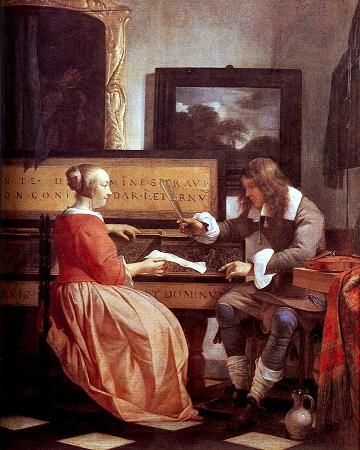Genre with Virginal. The virginals is a keyboard instrument of the harpsichord family. It was popular in Europe during the late Renaissance and early baroque periods. A virginal is a smaller and simpler rectangular or polygonal form of harpsichord with only one string per note running more or less parallel to the keyboard on the long side of the case. Many, if not most, of the instruments were constructed without legs, and would be placed on a table for playing. Later models were built with their own stands. The mechanism of the virginals is identical to the harpsichord 's, in that its wire strings are plucked by plectra mounted in jacks. Its case, however, is rectangular or polygonal, and the single choir of strings, one per note, runs roughly parallel to the keyboard. The strings are plucked either at one end, as with the harpsichord, or, in the case of the muselar, nearer the middle, producing a richer, flute-like tone. The origin of the name is obscure. It may derive from the Latin virga meaning a rod, perhaps referring to the wooden jacks that rest on the ends of the keys, but this is unproven. Another possibility is that the name derives from the word virgin, as it was most commonly played by young women, or from its sound, which is like a young girl's voice. A further view is that the name derives from the Virgin Mary as it was used by nuns to accompany hymns in honour of the Virgin. In England, during the Elizabethan and Jacobean eras, any stringed keyboard instrument was often described as a virginals, and could equally apply to a harpsichord or possibly even a clavichord or spinet. Thus, the masterworks of William Byrd and his contemporaries were often played on full-size, Italian or Flemish harpsichords, and not only on the virginals as we call it today. Contemporary nomenclature often referred to a pair of virginals, which implied a single instrument, possibly a harpsichord with two registers, or a double virginals. Like the harpsichord, the virginals has its origins in the medieval psaltery to which a keyboard was applied, probably in the 15th century. The first mention of the word is in Paulus Paulirinus of Prague's Tractatus de musica of around 1460 where he writes: The virginal is an instrument in the shape of a clavichord, having metal strings which give it the timbre of a clavicembalo. It has 32 courses of strings set in motion by striking the fingers on projecting keys, giving a dulcet tone in both whole and half steps. It is called a virginal because, like a virgin, it sounds with a gentle and undisturbed voice. The OED records its first mention in English in 1530, when King Henry VIII purchased five instruments so named. Small early virginals were played either in the lap, or more commonly, rested on a table, but nearly all later examples were provided with their own stands. The heyday of the virginals was the latter half of the 16th century to the later 17th century until the high baroque period when it was eclipsed in England by the bentside spinet and in Germany by the clavichord. Spinet virginals were made principally in Italy, England and Flanders. The keyboard is placed left of centre, and the strings are plucked at one end, although farther from the bridge than in the harpsichord. This is the more common arrangement for modern instruments, and an instrument described simply as a virginal is likely to be a spinet virginals. The principal differences in construction lie mainly in the placement of the keyboard: Italian instruments invariably had a keyboard that projected from the case, whilst northern virginals had their keyboards recessed in a keywell. The cases of Italian instruments were made of cypress wood and were of delicate manufacture, whilst northern virginals were usually more stoutly constructed of poplar. Early Italian virginals were usually hexagonal in shape, the case following the lines of the strings and bridges, and a few early Flemish examples are similarly made. From about 1580 however, nearly all virginals were rectangular, the Italian models often having an outer case like harpsichords from that country. There are very few surviving English virginals, all of them late. They generally follow the Flemish construction, but with a vaulted lid. Muselars were made only in northern Europe. Here, the keyboard is placed right of centre and the strings are plucked about one-third the way along their sounding length. This gives a warm, rich, resonant sound, with a strong fundamental and weak overtones. However, this comes at a price: the jacks and keys for the left hand are inevitably placed in the middle of the instrument's soundboard, with the result that any mechanical noise from these is amplified.
more...








